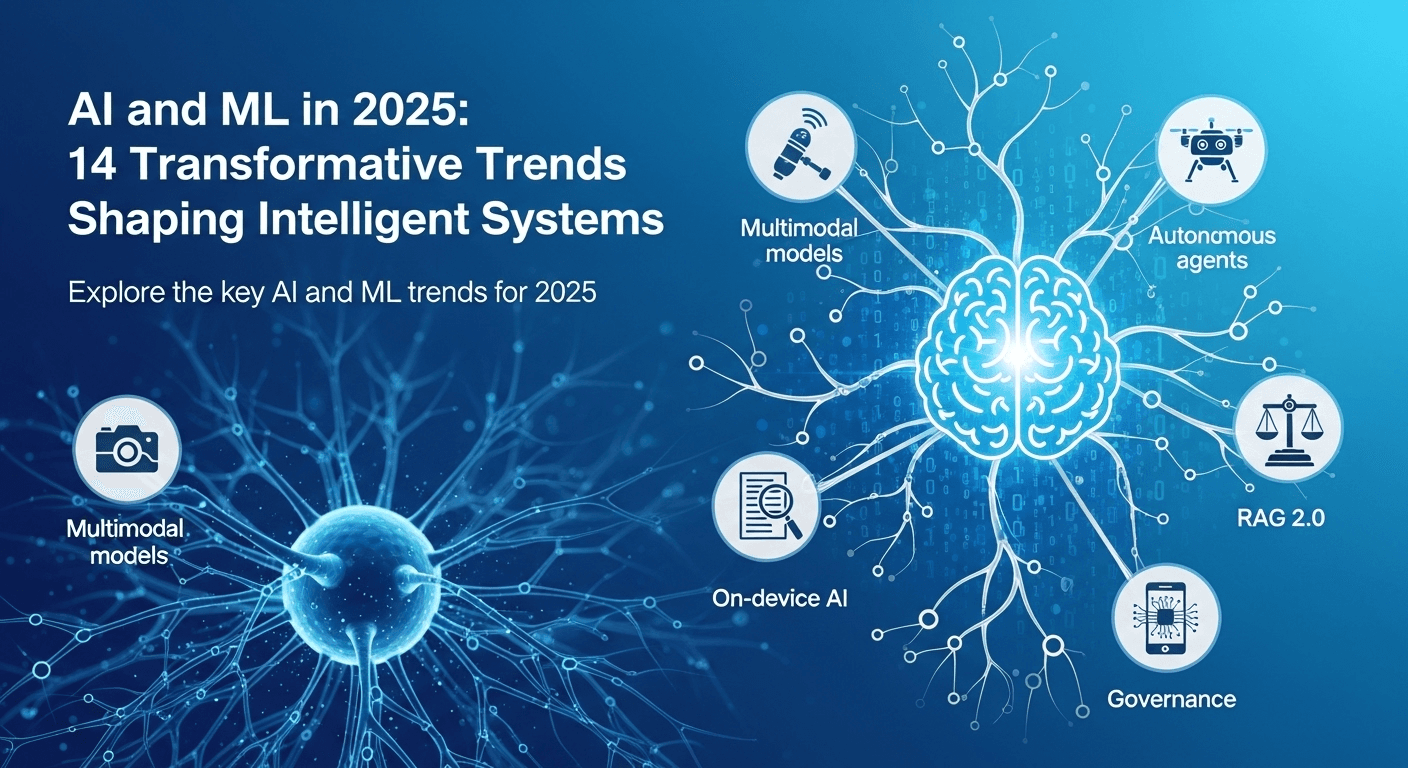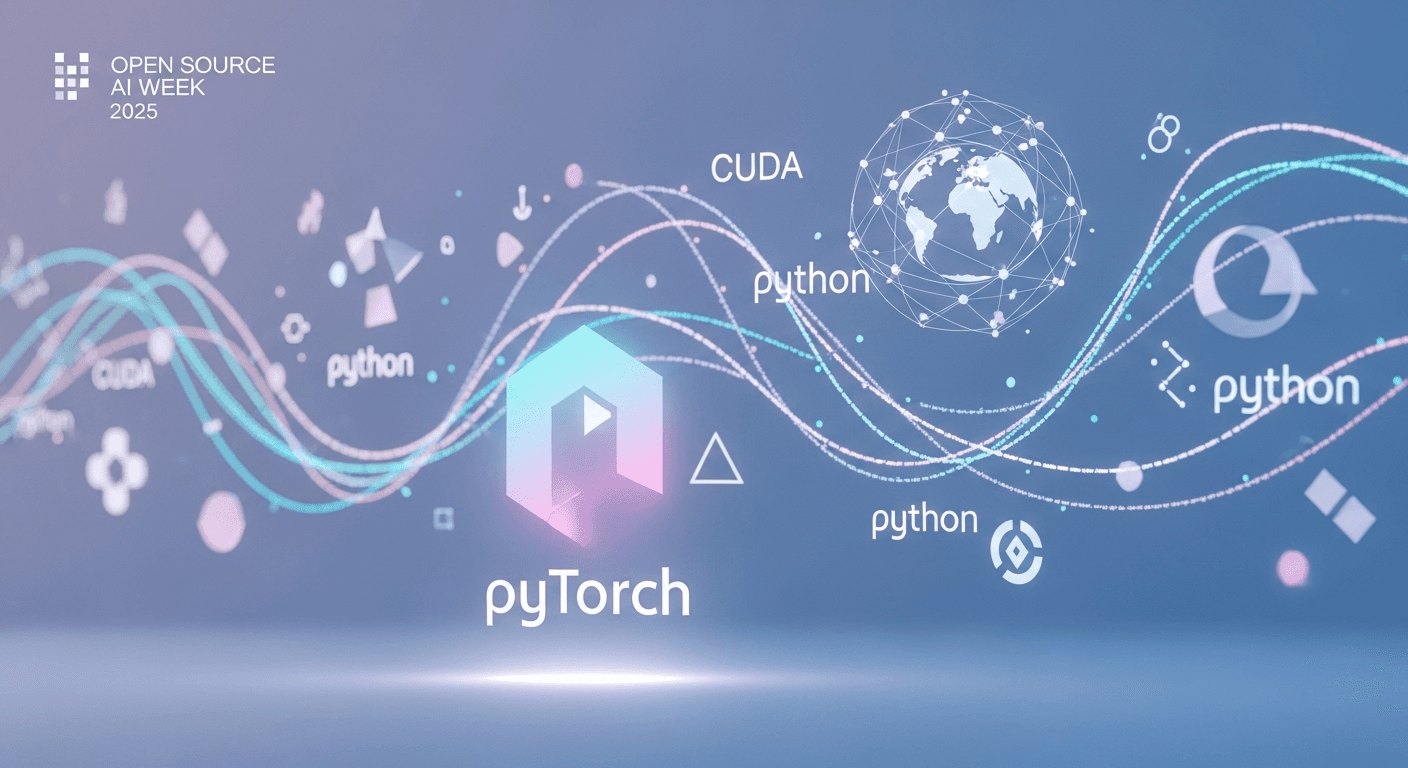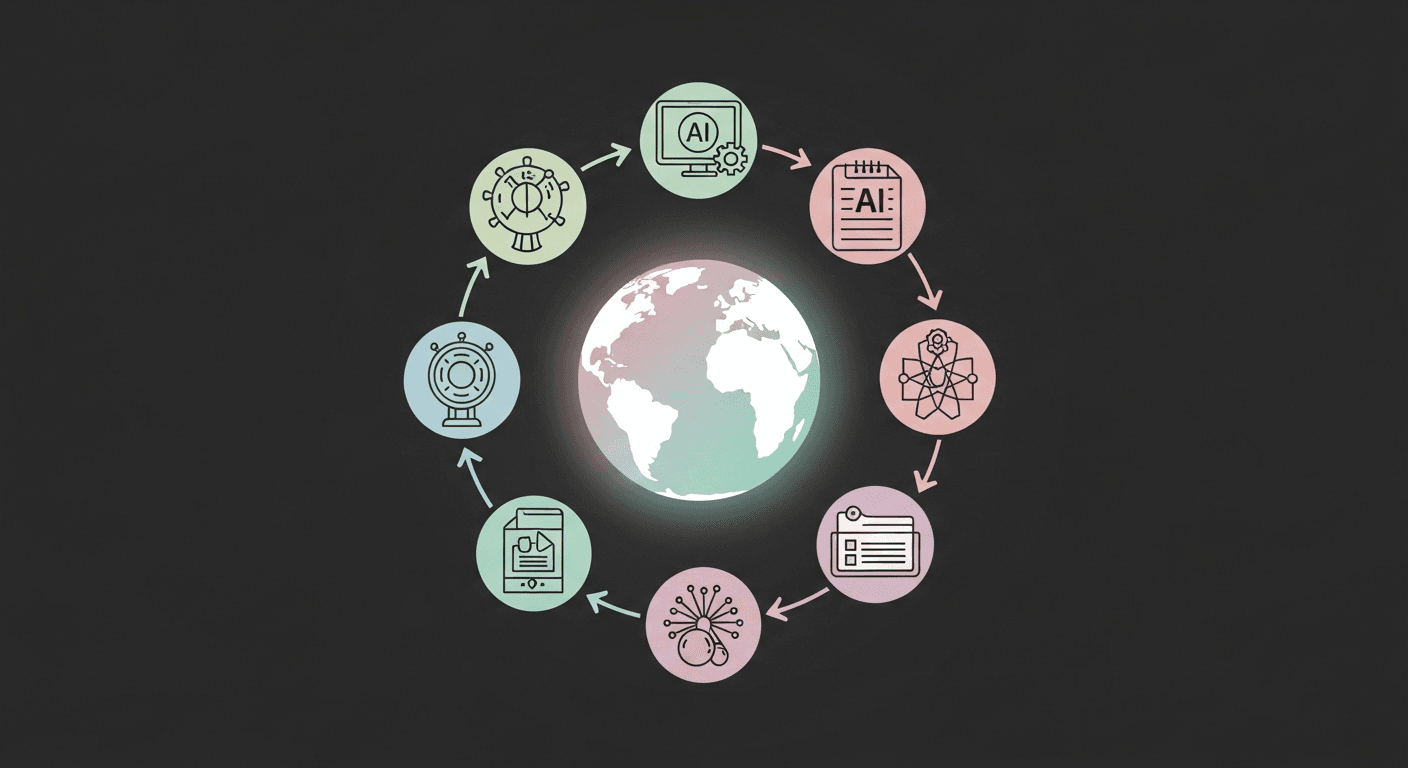AI and ML in 2025: 14 Transformative Trends Shaping Intelligent Systems

Artificial intelligence has evolved far beyond mere demos and pilot projects. By 2025, AI and machine learning will be integrated into products, workflows, and everyday devices on a much deeper level. Costs are falling, models are becoming multimodal and more sophisticated, and organizations are transitioning from experimentation to larger-scale implementations. This guide outlines the most significant AI and ML trends for 2025, the driving forces behind them, and how to effectively prepare. It is aimed at curious readers, AI practitioners, and business leaders seeking a clear, unbiased perspective based on reliable sources.
Why 2025 Is a Crucial Year
Several key factors are converging:
- Innovations in multimodal models that can process text, images, audio, and video within a single framework, such as OpenAI GPT-4o and Google Gemini 1.5.
- Increased enterprise adoption accompanied by reported productivity gains from leading surveys and reports like those from McKinsey and the Stanford AI Index.
- Emerging hardware platforms such as NVIDIA Blackwell, Google Cloud TPU v5p, and AMD MI300 are lowering latency and cost per token.
- Regulatory frameworks are evolving, including the EU AI Act, the NIST AI Risk Management Framework, and various global safety initiatives.
Trend 1: Multimodal AI Goes Mainstream
Generative AI is expanding beyond text. Models that can comprehend and generate across multiple modalities are being integrated into consumer applications and corporate workflows. Noteworthy examples include:
- GPT-4o for real-time speech, vision, and text processing.
- Gemini 1.5 featuring long-context comprehension and audio-visual interpretation.
- Llama 3.1 variants designed for multilingual and multimodal applications.
This matters because multimodality enables more sophisticated assistants, improved document processing, and advanced analytics that integrate tables, charts, screenshots, and voice commands. Anticipate broader applications in customer support, field services, and business intelligence.
Trend 2: Surge in Video Generation and Understanding
High-fidelity video generation is experiencing considerable advancements, with models like OpenAI Sora and Google Veo showcasing remarkably realistic scenes and enhanced control. Enterprises are already exploring:
- Marketing video drafts to expedite creativity.
- Simulation data for robotics and autonomous systems.
- Video search and summarization for compliance, media, and legal teams.
Expect 2025 to introduce more robust safety protocols, enhanced editing capabilities, and adherence to content provenance standards like C2PA.
Trend 3: Agents and Autonomous Workflows Shift from Pilot to Production
The role of AI is evolving from mere chat interactions to actionable insights. Agentic systems combine model calls, tools, and memory to perform complex tasks such as booking meetings, updating CRMs, placing orders, and reconciling reports. Maturing frameworks like Assistants APIs and AutoGen enable companies to introduce internal agents backed by role-based access controls and audit trails.
Design principles for 2025 will emphasize:
- Tool utilization over mere generation: agents will leverage searches, databases, and business APIs for accuracy.
- Granular permissions: adopt least-privilege protocols and per-action approvals to mitigate risks.
- Inbuilt observability: ensure event logs, traces, and human oversight checkpoints are part of the system.
Surveys such as McKinsey’s 2024 State of AI indicate a rise in enterprise deployment and initial ROI, particularly in customer operations, software engineering, and marketing.
Trend 4: RAG 2.0 – Evolving from Basic Retrieval to Grounded, Governed Knowledge
Retrieval-augmented generation (RAG) is a fundamental strategy for ensuring model accuracy and relevance. In 2025, RAG is advancing:
- Hybrid search techniques integrating vector queries with keyword and metadata filters for enhanced precision. Explore hybrid search guidance.
- Graph-RAG utilizing knowledge graphs or structured relationships to improve grounding. Learn more in NVIDIA’s RAG 2.0 overview.
- Document governance focused on citation enforcement, snippet-level attribution, and policy checks.
Action Steps: Treat your enterprise knowledge as a product by defining ownership, ensuring up-to-date information, and crafting embedding pipelines. Implement evaluation suites to assess accuracy, relevance, and latency with your datasets.
Trend 5: Emphasis on Smaller, Faster, and On-Device Models
Not every scenario requires a cutting-edge model. Smaller models are becoming increasingly capable and efficient, offering low-latency and privacy-friendly experiences.
- Microsoft Phi-3 demonstrates robust performance with a smaller parameter count.
- Meta Llama 3.1 includes 8B models that are competitive across various tasks.
- Apple Intelligence exemplifies a blend of on-device and private cloud processing on consumer devices.
Approaches like quantization (4-bit and 8-bit), LoRA fine-tuning, and distillation are now established methods that help reduce costs and latency while maintaining quality for specific tasks.
Trend 6: Synthetic Data as a Force Multiplier (with Guardrails)
When high-quality labeled data is in short supply, synthetic data can enhance model performance considerably, particularly for safety testing, edge cases, and multilingual support. It is increasingly utilized for computer vision, tabular modeling, and to pretrain or augment large language models (LLMs). However, it’s essential to manage feedback loops from model-generated content, as they can lead to diminished quality. Implement robust validation, deduplication, and expert reviews. Reference industry reports and research from the Stanford AI Index for examples.
Trend 7: LLMOps Matures – From Prototypes to Reliable Systems
Deploying AI functionalities is increasingly resembling software development disciplines, incorporating CI/CD for prompts, test sets for model behavior, and production monitoring for drift and safety. Key pillars include:
- Evaluations and guardrails: unit tests for prompts, golden datasets, and adversarial probes.
- Observability: tracking token usage, costs, and latency budgets for each feature.
- Safety assessments: implementing red-teaming and policy compliance checkpoints.
Frameworks and standards play a significant role: the NIST AI RMF for risk management and OWASP Top 10 for LLM Applications for security risks are gaining traction. Some organizations are also piloting ISO/IEC 42001 standards for AI management systems.
Trend 8: Responsible AI and Regulation Become Operational
The governance landscape has rapidly advanced. The EU AI Act establishes risk-based obligations with implementation timelines. Meanwhile, the United States continues to refer to frameworks like the NIST AI RMF, while international initiatives like the Bletchley Declaration and Seoul AI Safety Summit promote interoperability.
For teams, this entails mapping use cases to risk categories, documenting training data and model lineage, ensuring content provenance (for instance, through C2PA), and instituting bias and privacy reviews within the product development lifecycle.
Trend 9: Security by Design for AI Systems
As AI systems accrue value, they also introduce new risks such as prompt injection, data exfiltration, model theft, and jailbreaks. Begin with a thorough threat model and reinforce your system:
- Isolate tools and data, utilize allowlists for model function calls, and ensure rigorous input validation.
- Adopt the OWASP LLM Top 10 and employ adversarial testing tools like MITRE ATLAS.
- Incorporate content provenance for generated media and watermarking as appropriate, while acknowledging current technical limitations.
Trend 10: Hardware Acceleration and Cost Curves Redefine Possibilities
Cost and latency in inference are crucial for product viability. New accelerators are addressing these challenges:
- NVIDIA Blackwell introduces architectural enhancements for faster, more efficient training and inference.
- Google Cloud TPU v5p optimizes pricing and performance for training clusters.
- AMD MI300 offers increased memory capacity for large model inference.
On the software side, optimizations like 4-bit inference, speculative decoding, and Mixture-of-Experts architectures enhance throughput without sacrificing quality across numerous tasks.
Trend 11: Vertical Copilots Become Measurable
We are transitioning from generic chatbots to specialized domain copilots that deliver tangible results. Examples include coding assistants, customer service copilots, and analytics helpers. Evidence of effectiveness is expanding: studies and reports highlight time savings and improved quality in specific tasks, such as Noy & Zhang (Science, 2023) on writing productivity and GitHub Copilot research on developer efficiency.
In 2025, the focus will be on connecting copilots to essential tools, enhancing retrieval for company knowledge, and measuring outcomes to validate value and adjust for ROI.
Trend 12: Data Strategy, IP, and Privacy by Default
Data remains a critical bottleneck. Organizations are prioritizing data contracts, retention policies, and privacy-preserving fine-tuning to mitigate risks. Ongoing legal discussions regarding training data and fair use continue, particularly in textual and image contexts. In 2025, best practices will emphasize consent-driven data collection, clear provenance, and the separation of customer data from any foundational model pretraining unless explicitly licensed.
Trend 13: Emphasis on Multilingual and Local-First AI
Global teams require assistants that grasp regional languages and contexts. Improvements in multilingual models and translation pipelines are evident, and smaller local models are enabling sensitive workloads to run on private infrastructures. Initiatives like Llama 3.1 demonstrate robust multilingual capabilities, while Apple Intelligence showcases hybrid local-cloud processing.
Trend 14: From Simulation to Reality – Advancements in Robotics and Embodied AI
Embodied AI merges foundational models with sensors and actuators. Research advancements, including Google’s RT-2 and large-scale imitation learning (like RT-X), connect web knowledge with practical tasks. In 2025, expect pragmatic applications such as warehouse automation, quality control, and mobile assistance, supported by better simulators and synthetic data with human oversight for edge cases.
What These Trends Mean for Teams in 2025
To translate trends into actionable results, focus on developing a well-rounded roadmap:
- Begin with a focused, high-impact copilot or agent that integrates with real tools and data.
- Invest in RAG and knowledge pipelines before diving into extensive fine-tuning.
- Select the smallest model that meets quality targets; scale up only as necessary.
- Incorporate evaluation metrics, guardrails, and observability from the outset.
- Align use cases with regulatory requirements and document data provenance.
- Set sustainability objectives for AI workloads and monitor energy consumption. Refer to the IEA on data center energy.
Conclusion
AI in 2025 is focused on responsible scalability. With advancements in multimodal models, efficient on-device inference, enhanced retrieval techniques, and stronger governance, prototypes are evolving into reliable products. Organizations that will thrive will combine credible evaluations with targeted use cases, optimally sized models, and transparent data practices. Although technology is progressing rapidly, the strategic playbook is becoming increasingly clear.
FAQs
What distinguishes a chatbot from an AI agent?
Chatbots primarily respond to inquiries, while AI agents plan and execute tasks using tools and APIs, complete with memory and safety protocols. By 2025, many agents will incorporate human oversight.
Is fine-tuning a large model necessary for my specific use case?
In many cases, the answer is no. Start with retrieval-augmented generation and prompt engineering on a capable base model. Fine-tuning should be reserved for when you possess task-specific data requiring consistent behavior unattainable through RAG alone.
How can I assess AI quality in a production setting?
Utilize evaluation sets that reflect your data and tasks, inclusive of adversarial prompts. Monitor aspects such as factual accuracy, relevance, harmful content rates, latency, and costs. Incorporate human reviews for critical decision-making.
Is on-device AI suitable for enterprises?
Yes, for designated workloads. Smaller models utilizing quantization can operate on laptops or mobile devices, ensuring privacy and low latency. Hybrid patterns that blend on-device and private cloud solutions are becoming prevalent.
What are the most pressing AI risks to consider?
Key risks include data leakage, prompt injection, biased outputs, compliance lapses, and uncontrolled expenditures. Mitigate these risks through role-based access controls, retrieval governance, evaluations, red-teaming exercises, and budget guidelines for features.
Sources
- Stanford AI Index Report
- McKinsey – The State of AI in 2024
- OpenAI – GPT-4o
- OpenAI – Sora
- Google – Gemini 1.5
- Google – Veo
- Meta – Llama 3.1
- Microsoft – Phi-3
- Apple – Apple Intelligence
- NVIDIA – Blackwell Platform
- Google Cloud – TPU v5p
- AMD – Instinct MI300
- NIST – AI Risk Management Framework
- OWASP – Top 10 for LLM Applications
- MITRE ATLAS – Adversarial Threats to ML
- EU AI Act – European Parliament
- UK Government – Bletchley Declaration
- UK Government – Seoul AI Safety Summit
- C2PA – Content Provenance
- IEA – Data Centres and Data Transmission Networks
- Google – Robotics Transformer (RT-2)
- NVIDIA – RAG 2.0
- Science – Experimental evidence on the productivity effects of generative AI
- GitHub – Copilot research roundup
Thank You for Reading this Blog and See You Soon! 🙏 👋
Let's connect 🚀
Latest Blogs
Read My Latest Blogs about AI

Inside Open Source AI Week: How PyTorch, CUDA Python, and a Global Community Are Advancing AI
Open Source AI Week highlights how PyTorch, CUDA Python, and open models are pushing the frontiers of AI. Discover key events, tools, and practical insights for developers in 2025.
Read more


